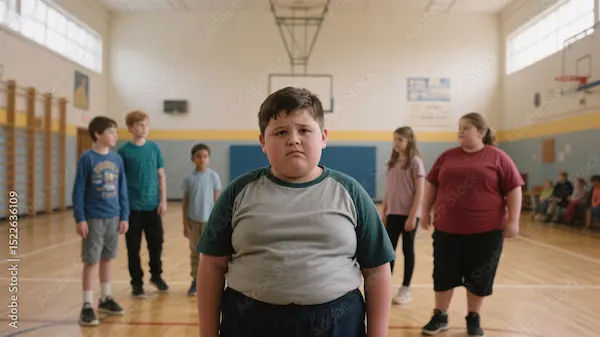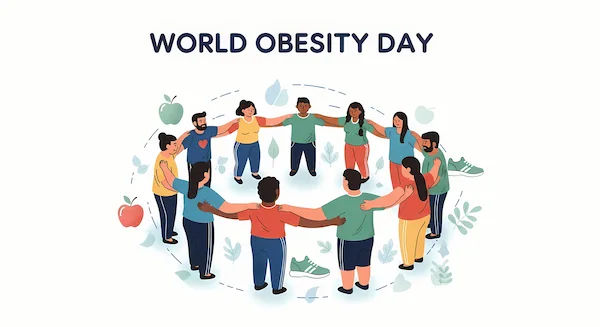Guide to Childhood Obesity
A complete guide for parents to prevent and manage childhood obesity. Learn the causes, health risks, and practical strategies for healthy eating, active lifestyles, sleep, and emotional support to help your child thrive.


Introduction
Childhood obesity is more than just a few extra pounds. It's a complex health issue that affects millions of children worldwide, increasing their risk of physical and emotional problems now and in the future. As a parent, navigating this challenge can feel overwhelming. You might be worried about your child's health, confused by conflicting advice, or unsure where to start. This guide is designed to empower you with knowledge, compassion, and practical strategies. We'll break down the causes of obesity in kids, explore the very real health consequences, and most importantly, provide a clear, actionable roadmap for preventing childhood obesity and fostering a lifetime of healthy habits for your entire family. Remember, this journey isn't about perfection; it's about progress, support, and love.
What is Childhood Obesity? Understanding the Basics
Defining Childhood Obesity: Beyond the Numbers
Unlike adult obesity, which is typically measured by Body Mass Index (BMI) alone, childhood obesity is defined using age- and sex-specific BMI percentiles. A child's BMI is plotted on a growth chart to determine their percentile.
Generally, a child is considered overweight if their BMI is at or above the 85th percentile and below the 95th percentile for children of the same age and sex. Childhood obesity is defined as a BMI at or above the 95th percentile. This method accounts for the fact that children's body composition changes as they grow. However, it's crucial to see this as a starting point for a conversation with a healthcare professional, not a final label.
The Alarming Statistics: A Global Health Crisis
The numbers paint a stark picture. According to the World Health Organisation (WHO), over 390 million children and adolescents aged 5-19 were overweight or obese in 2022. The prevalence has risen dramatically, from just 4% in 1975 to over 18% in 2016. In many countries, including India, this rise is linked to rapid nutrition transition—increased consumption of energy-dense, nutrient-poor foods high in fat and sugar, coupled with decreased physical activity. These childhood obesity statistics highlight a pressing public health issue that requires immediate and sustained attention from families, communities, and governments.
Consult a Paediatrician for the best advice
Root Causes: Why Childhood Obesity Occurs
Dietary Habits: The Role of Sugar, Processed Foods, and Portions
The most significant contributor is an energy imbalance—consuming more calories than the body uses. The modern
diet is often the culprit:
- Sugary Drinks: Sodas, fruit juices, and sports drinks are laden with empty calories and offer no nutritional value.
- Processed Foods: Easy, convenient snacks like chips, cookies, and frozen meals are typically high in unhealthy fats,
sugars, and salt. - Large Portions: Restaurant and packaged food portions have ballooned, distorting our perception of a healthy serving size.
The Sedentary Lifestyle: Screens vs. Playtime
Children today spend significantly more time on sedentary activities like watching television, playing video games, and
using smartphones and tablets. This screen time not only reduces time for active play but is also often accompanied by
mindless snacking. Replacing active outdoor play with passive entertainment is a major driver of weight gain.
Genetic, Hormonal, and Environmental Factors
While lifestyle is primary, other factors play a role. Genetics can influence how a child's body processes food and stores
fat. Rarely, hormonal conditions like an underactive thyroid can contribute. The "obesogenic" environment is also
key—this includes the lack of safe parks, the abundance of fast-food advertising targeted at children, and limited access
to affordable, healthy fresh food in some neighborhoods.
The Ripple Effect: Health Risks of Childhood Obesity
Physical Health Complications: From Diabetes to Sleep Apnea
Childhood obesity is linked to a host of health problems once seen only in adults:
- Type 2 Diabetes: A condition where the body doesn't use insulin properly, closely linked to excess weight.
- Heart Disease: High cholesterol and high blood pressure are common in children with obesity, building the foundation
for future cardiovascular problems. - Asthma and Sleep Apnea: Excess weight can press on airways, making breathing difficult during sleep and contributing
to asthma. - Joint Pain: Extra weight stresses hips, knees, and back, leading to pain and mobility issues.
Psychological and Social Impact: Bullying and Self-Esteem
The emotional toll can be just as devastating. Children with obesity often face stigma, teasing, and bullying from peers.
This can lead to:
- Low self-esteem and negative body image.
- Higher rates of depression and anxiety.
- Social isolation and behavioral problems.
These psychological effects can create a vicious cycle, where a child uses food for comfort, leading to further weight
gain.
How to Prevent Childhood Obesity: Building Healthy Foundations
Nutritional Strategies for the Whole Family
- Focus on shaping habits, not restrictive dieting.
- Lead by Example: Eat healthy foods yourself. Children mimic what they see.
- Stock a Healthy Kitchen: Fill your home with fruits, vegetables, whole grains, and lean proteins. Make unhealthy
options less accessible. - Involve Kids in Cooking: Children are more likely to try foods they helped prepare.
- Practice Structured Mealtimes: Eat together as a family without screens. This encourages mindful eating.
Making Physical Activity a Fun Family Habit
- Aim for at least 60 minutes of moderate to vigorous activity daily.
- Make it Play: Don't call it "exercise." Go for family walks, bike rides, play tag, or dance in the living room.
- Find Their Passion: Encourage enrollment in sports, martial arts, or dance classes they genuinely enjoy.
- Limit Screen Time: Set clear rules for TV, video games, and phone use. The American Academy of Paediatrics recommends consistent limits for children ages 6 and older.
The Power of Sleep and Routine
Inadequate sleep is a surprising but major risk factor. Poor sleep disrupts hormones that regulate hunger (ghrelin) and
fullness (leptin), leading to increased appetite. Establish a consistent bedtime routine and ensure your child gets the
recommended amount of sleep for their age (9-12 hours for school-aged children).
Managing Childhood Obesity: A Supportive Approach
How to Talk to Your Child About Weight Healthily
- The conversation requires sensitivity. Focus on "health" and "feeling good," not "weight" or "diet."
- Use Positive Language: Talk about "being strong," "having energy," and "taking care of our bodies."
- Focus on the Whole Family: Frame changes as a family project, not something the child must do alone. Say, "Let's all
try to be healthier together." - Listen: Understand their feelings and challenges. Be their biggest supporter, not their critic.
When to Seek Professional Help: The Role of Doctors and Nutritionists
You don't have to do this alone. If you are concerned about your child's weight or the health risks of childhood obesity,
it's crucial to consult a professional. A paediatrician can calculate your child's BMI percentile accurately, rule out any
underlying medical causes, and provide tailored guidance. If your child's BMI is consistently high, a doctor can help
you create a safe and effective management plan. For personalised nutritional advice, consulting a registered dietitian
can be incredibly beneficial. If you're unsure where to start, you can consult a paediatrician online with Apollo24|7 for
an initial evaluation and advice on the next steps.
Conclusion
Addressing childhood obesity is one of the most important investments we can make in our children's future. It's a journey that requires patience, empathy, and a commitment to long-term health over short-term fixes. By understanding the complex causes, from diet and activity levels to sleep and environment, we can create a supportive framework for our children to thrive. Remember, the goal isn't a specific number on a scale but to equip our kids with the knowledge and habits they need for a long, healthy, and happy life. Start with one positive change today—perhaps a family walk after dinner or swapping out sugary drinks for water—and build from there. Your support is the most critical factor in their success.
Consult a Paediatrician for the best advice
Consult a Paediatrician for the best advice

Dr. Kathirvel. M
Medical Geneticist
3 Years • MBBS, MD Pediatrics (JIPMER), DM Medical Genetics (AIIMS,New Delhi)
Chennai
Apollo Hospitals Greams Road, Chennai

Dr. Suhena Sengupta
Paediatrician
15 Years • MBBS, IPPC
Kolkata
MCR SUPER SPECIALITY POLY CLINIC & PATHOLOGY, Kolkata

Dr. Jayati Das
Paediatrician
9 Years • MBBS , MD (Paediatrics)
Howrah
Bijaya Clinic, Howrah

Dr. Maitreyee Mallick
Paediatrician
7 Years • MBBS, MD (Paed.)
Bansdroni
Siddhita Healthcare., Bansdroni

Dr. Anveez M A
Paediatrician
7 Years • MBBS, MD (Paed.)
Bansdroni
Siddhita Healthcare., Bansdroni
Consult a Paediatrician for the best advice

Dr. Kathirvel. M
Medical Geneticist
3 Years • MBBS, MD Pediatrics (JIPMER), DM Medical Genetics (AIIMS,New Delhi)
Chennai
Apollo Hospitals Greams Road, Chennai

Dr. Suhena Sengupta
Paediatrician
15 Years • MBBS, IPPC
Kolkata
MCR SUPER SPECIALITY POLY CLINIC & PATHOLOGY, Kolkata

Dr. Jayati Das
Paediatrician
9 Years • MBBS , MD (Paediatrics)
Howrah
Bijaya Clinic, Howrah

Dr. Maitreyee Mallick
Paediatrician
7 Years • MBBS, MD (Paed.)
Bansdroni
Siddhita Healthcare., Bansdroni

Dr. Anveez M A
Paediatrician
7 Years • MBBS, MD (Paed.)
Bansdroni
Siddhita Healthcare., Bansdroni
More articles from Obesity
Frequently Asked Questions
1. What is a healthy weight for my child?
A healthy weight is best determined by a paediatrician using a BMI-for-age percentile chart. They will consider your child's unique growth pattern, build, and overall health. There's no single 'ideal' number for all children of the same age.
2. Are some children genetically predisposed to obesity?
Yes, genetics can play a role by influencing how the body stores fat and regulates appetite. However, genes are not destiny. A healthy environment with good nutrition and plenty of activity can powerfully influence a child's health trajectory, even with a genetic predisposition.
3. How can I help an obese child without giving them a complex?
Focus on the whole family's health, not just the child's weight. Use positive language about 'being healthy and strong.' Praise efforts and non-scale victories, like choosing a healthy snack or completing a physical activity. Most importantly, ensure they feel loved and supported unconditionally.
4. What are the best diet plans for overweight children?
Avoid fad or restrictive diets for children, as they can harm growth and development. Instead, focus on sustainable changes: more fruits and vegetables, whole grains, lean proteins, and water. The best 'diet' is a balanced, nutritious eating pattern adopted by the entire family. For a personalised plan, consult a registered dietitian.
5. My child is obese; will they always be overweight?
Not necessarily. Childhood doesn't have to determine adulthood. Early intervention with healthy lifestyle changes can significantly alter a child's path. Teaching them healthy habits gives them the tools to manage their weight effectively throughout their life, breaking the cycle of obesity.




.webp)